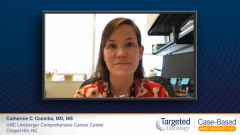
Patient Factors for Selecting Treatment in R/R CLL
Catherine Coombs, MD, MS, reviews factors that impact the selection of treatment in patients with CLL.
Episodes in this series

Catherine Coombs, MD, MS: Selecting treatment in the relapsed/refractory setting, it’s very important to consider a number of patients-specific factors. This is pretty similar to the frontline setting, in my view. The first is what are the patient’s comorbidities? This is important because all of our therapies have potential adverse effects. One example is that with patients for whom I’m considering venetoclax, this therapy may be a little less attractive if a patient has significant renal dysfunction, given that a patient with kidney dysfunction would likely then be at much higher risk for tumor lysis syndrome complications. On the contrary, we use a lot of BTK [Bruton tyrosine kinase] inhibitors, which are excellent drugs. However, these drugs are known to have cardiac adverse effects; they could increase the risk of a patient developing atrial fibrillation. There have also been lots of studies showing that these can lead patients to develop hypertension or worsen existing hypertension. All of these factors are important in considering what the risk/benefit of each given line of therapy is, whether frontline or relapsed/refractory.
There’s also importance to disease-specific features. I talked about patient risk factors. What about the patient’s underlying CLL [chronic lymphocytic leukemia] features? This was very important back when we were using chemoimmunotherapy. What we know is back in the chemotherapy days, patients with TP53 aberrations had very poor responses to chemoimmunotherapy, so we typically avoided that as a class altogether. Now, I’m using very little chemotherapy, given that we have novel agents that work much better. The other blessing of these new agents is that they do work quite well in individuals with poor-risk features. I would say the molecular features play a little less of a role. However, I think they’re still very important. The reason they’re important is, especially when it comes to venetoclax, in long-term follow-up of the CLL14 trial, which is what led to the approval of venetoclax and obinutuzumab in the frontline, we can see a very different response with respect to progression-free survival [PFS] based upon whether a patient has poor-risk features.
Take this patient for example, he has unmutated IGHV. The median [PFS] for poor-risk patients with unmutated IGHV is 57 months compared to the entire patient population, where this median has not yet been reached. Similarly, for individuals with TP53 aberrations, the median [PFS] is 49 months compared to not reached for the entire patient population. What we know is that though that regimen works very well even in patients with these poor-risk markers, it may not work for quite as long. The good news with BTK inhibitors, we have some long-term follow-up from ibrutinib, and we see that drug works pretty much just as well for patients with unmutated compared to mutated IGHV. As far as ibrutinib for patients with TP53 aberrations, it probably works almost as well. We don’t have huge studies on this because a lot of patients with TP53 were excluded from the pivotal phase 3 trials. But overall, I think those factors are important, but maybe not as critically so as they were in the chemotherapy era.
Transcript edited for clarity.






































